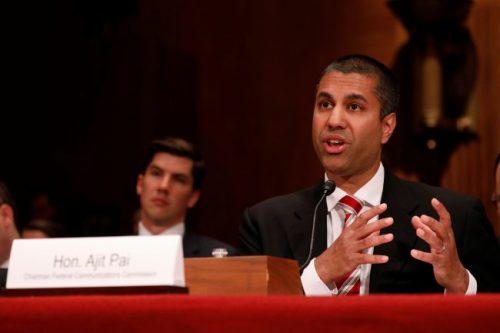
With the presidential election behind us (and make no mistake, it’s over), scholars are beginning to consider what tech policy under a Joe Biden administration may look like. There are several fascinating questions, including whether Donald Trump’s antitrust case will proceed against companies that largely supported Biden’s campaign and helped shape Barack Obama administration tech policy. But before getting there, it’s worthwhile to reflect on how Ajit Pai’s chairmanship has shaped the Federal Communications Commission (FCC) and the future of tech policy.

Substantive reforms
For most, Pai’s chairmanship will be defined by the FCC’s
policy initiatives over the past four years. These include:
- Net neutrality and Title II. Easily, the most high-profile Pai-era initiative was the Restoring Internet Freedom Order (RIFO), which repealed the Obama FCC’s Open Internet Order and restored the light-touch regulatory scheme that governed most broadband providers since the industry’s infancy. The arguments about common carriage obligations have been well-canvassed, and I won’t repeat them here. But the proof is in the pudding: Despite assurances that the repeal would “end the internet as we know it,” none of the parade of horribles touted by net neutrality advocates (such as paying $2 per Google search or suffering with a network that loaded “one . . . word . . . at . . . a . . . time”) ever came to pass. Since the repeal, average internet speeds doubled and fiber deployment increased. More significantly, this lightly regulated network architecture carried America through the greatest stress test imaginable when the pandemic shifted much of our economic and social life online. The transition was technologically seamless; perhaps the most remarkable aspect of the pandemic from a tech perspective was how uneventful that transition was for most Americans.
- Rural broadband. Although the RIFO grabbed headlines, Pai’s self-professed “top priority” was to close the urban-rural digital divide. Since 2016, the number of Americans without high-speed internet access fell 46 percent. The agency completed Phase 2 of the Connect America Fund process, which awarded $1.5 billion to subsidize rural buildout. This was followed by a whopping $20.4 billion Rural Digital Opportunity Fund to wire areas that remain unserved. Both adopted a market-oriented reverse auction process designed to get the biggest impact for taxpayer dollars.
- Spectrum reallocation. The Pai FCC has also aggressively pushed to repurpose underused spectrum for wireless communication. Over the past four years, the agency has taken a flexible, creative, and evidence-based approach to freeing up spectrum resources. These have included proposals for licensed and unlicensed spectrum, lifting barriers to deployment, experiments with advanced spectrum sharing, and even creative partnerships with state regulators. Pai and his colleagues deserve credit for standing firm on the need for more efficient spectrum management, even in the face of significant political opposition.
Process reforms
With a significant assist from Commissioner Mike O’Rielly,
Pai has also changed the way the FCC does business. These reforms include:
- Enhanced transparency. From the outset, Pai established a tone of increased agency transparency, most notably by disclosing proposed items before the agency’s monthly meetings. This was a welcome change from the secrecy of his predecessor Tom Wheeler’s administration, where public discussion of proposed items was driven by strategic leaks to the media, and minority commissioners often complained about being left out of the loop on key initiatives. Pai’s transparency improved relationships among the commissioners and between the agency and the public, and one hopes these reforms will be permanent.
- Office of Economics and Analytics. In 2018, the FCC established a standalone Office of Economics and Analytics, which is tasked with assuring that economists’ voices are included in agency deliberations. This has helped bring cost-benefit analysis back to the forefront of agency decision-making, helping increase the likelihood that big decisions are driven by evidence and data rather than merely political pressure.
Personal poise
Finally, this retrospective is incomplete without
referencing how Pai himself has shaped public deliberations. In an era of
increasing polarization and petty personalization of politics, Chairman Pai has
approached his responsibilities with an upbeat attitude and sense of optimism,
peppering his speeches with pop culture references to make the agency more
relatable. He has been unusually active on social media, helping personalize an
often impersonal bureaucracy. This refreshing approach is all the more laudable
in light of the significant amount of racist, obscene, sometimes violent
harassment hurled at Pai personally by his opponents throughout his tenure.
Of course, the agency’s impressive production has been a
collaborative effort by Chairman Pai; Commissioners O’Rielly, Brendan Carr, Jessica
Rosenworcel, and Geoffrey Starks and former Commissioner Mignon Clyburn, all of
whom had a hand in the agency’s successes. In both cooperation and respectful
disagreement, the agency’s leaders have helped shape tech policy for the
better. And the agency’s capable and hardworking staff deserves a shout-out,
too. As we look ahead to the future of tech policy, the accomplishments of the
last four years should and will cast a long shadow over whatever comes next.
The post Reflections on the Pai chairmanship at the FCC appeared first on American Enterprise Institute – AEI.
